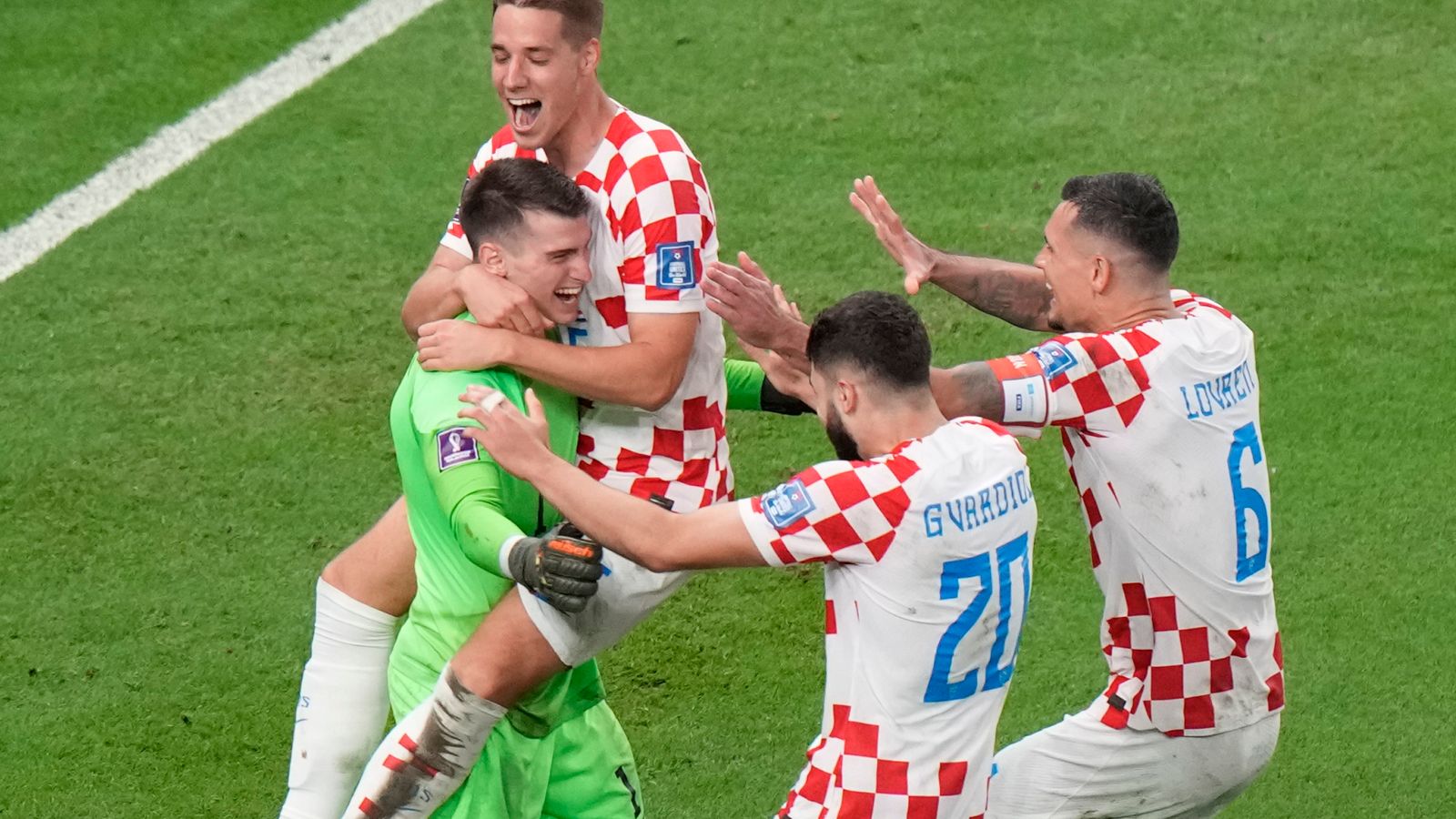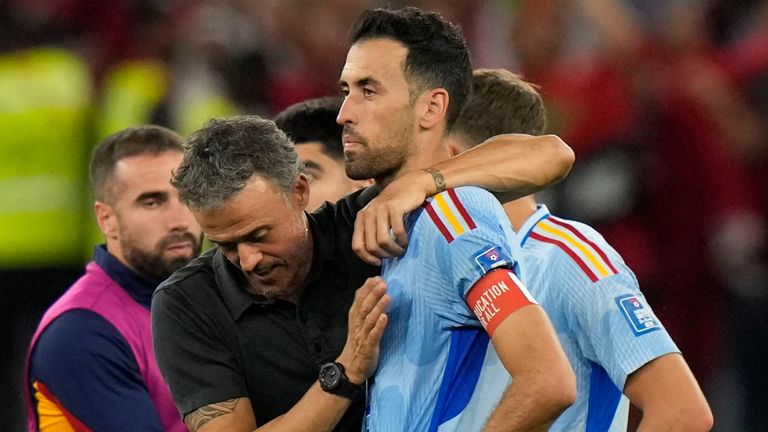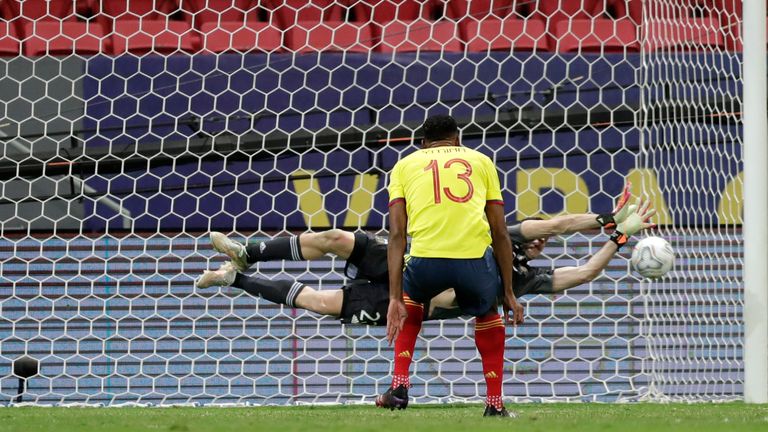
If Croatia or Morocco were to take their World Cup quarter-finals to a penalty shootout then expect to hear that it would favour them because of their record. But history suggests that the opposite is true for teams involved in a second tournament shootout.
Look at the penalty shootouts at the men’s World Cup, European Championship, Africa Cup of Nations and Copa America in the past decade. Nine of the 11 teams that had already won a shootout at the tournament lost the next one when facing a team in their first shootout.
Of the two that did win, one was Egypt at the Africa Cup of Nations earlier this year. They had to contest a third penalty shootout of the tournament in the final against Senegal – and lost. That leaves only Italy in the Euro 2020 final. They did still beat England. Of course.
But this record suggests that experience is not an advantage in shootouts. It might even tell us more than that. It is not a lottery or a coin toss either. The possibility exists that it is actually a significant disadvantage for a team to have contested a shootout just days earlier.
Imagine standing over that penalty in the knockout stages of a major tournament. It comes down to that kick. It all led here. The pressure is huge. This is not the time to try that penalty you had been toying with. Save that for when four goals up in a club game.
It goes in and there is elation. But what if you are put in the same situation later that week? Maybe it is not so uncomfortable now. That counts for something. But the opposition goalkeeper knows your favourite penalty. Everyone does. Can you do it again?
The individual records of those in that situation suggest many cannot. When a player has to take a penalty in another shootout, the numbers drop. There have been 38 such penalties during this period and only 22 have gone in – a conversion rate of just 58 per cent.
A dramatic example occurred at Euro 2020. Fabian Schar, Manuel Akanji and Ruben Vargas all scored for Switzerland in their win against France in the round of 16. The same three players all missed from the spot in their nation’s quarter-final defeat to Spain.
Spain then lost to Italy in the semi-final. Their first kick was missed by Dani Olmo, who had scored against Switzerland. Though Italy broke the cycle in the final at Wembley, Andrea Belotti and Jorginho were both denied just days after converting against Spain.
There is a conundrum for the taker. Having succeeded with their best penalty under intense pressure, do they stick with it even though the goalkeeper has seen it now? Or do they revert to their next-best penalty in the hope that they can execute that just as well?
‘Players have their favourite penalty’
“A lot of players have their favourite penalty, that is definitely true,” Dr Niklas Hausler tells Sky Sports. “It is very individual. No matter how many games you have played, that penalty that you shot in a youth game is going to stick differently in your brain.
“Let’s say you were 13 and very emotional and you missed that penalty. Maybe that means you think that you should never take this penalty ever again because you have a bad feeling about it. But maybe that penalty is the best technique for you now that you are 24.
“It is very natural for humans when we are in situations of increased stress to go back to your basics. You become very risk averse. You revert to the penalty that you feel most safe with. I think that is a very interesting hypothesis. Players should work on it more.”
Hausler is a German neuroscientist and the co-founder of neuro11, helping athletes to improve their precision by achieving an optimal mental state. He pitched his ideas to Jurgen Klopp at Liverpool and is now working with the squad on their penalties.
That involves studying brain waves to better understand what distracts players and discussing their psychological risk profile to establish what works best for them. It seems to work. Liverpool won both domestic cup finals last season following penalty shootouts.
“My PhD focused on how risk is processed in the brain. You might like the rollercoaster more than me. I have friends who like to take more financial risks than I do. Personalities are different. Some people are more open to new things. We have different profiles.
“When you have different risk profiles, you have to analyse the player based on that. What is your risk level and what is the risk you are willing to take? When you know this then you can make an informed decision and execute that. This is where we help.”
Increased pressure in penalty shootouts
It is difficult to establish any golden rules because every player is different. Even the popular notion that delaying after the referee has blown the whistle is not some panacea. Marcus Rashford waited 11 seconds after the whistle before dragging wide in the Euro 2020 final.
“It is actually very individual,” says Hausler.
“Some people benefit from more time. Some should go a bit quicker. That is something that we find out from the player so that he understands himself a bit better.”
Technique cannot be trained in isolation when the mental aspect is so huge. The conversion rate of World Cup penalties in normal play is around 80 per cent. In shootouts that drops to 70 per cent. Pressure plays its part in that. Even the walk to the spot is longer.
Conversion rates also dip for kicks later in the shootout, despite the fact that the better takers sometimes opt for the fourth or fifth penalties. Both Cristiano Ronaldo and Mohamed Salah have missed out on even taking penalties in shootout defeats by going fifth.
It tallies with research from the NBA that shows free-throw conversion percentages dip during clutch situations – defined as the last five minutes of games featuring a margin no larger than five points. This is a story of mental stress – and trying to mitigate it.
“We cannot recreate a World Cup final, of course. But we can know what helps the player to get into this automatic state, into what is known by many people as the zone. We literally measure the brain waves and feed it back to the player.
“We help the player to understand what things help them to optimise their routine. What is it that helps them and what is it that distracts them? I think that is unique. It is the first time in professional sports that this has been done. The results have been shown.”
Repetition and routine are important
Part of the problem with being asked to take a number of high-profile penalties at a World Cup is repetition. That demands many hours of practice and total belief. That belief is difficult when some of those taking the penalties are not regular takers for their club side.
“The Gareth Bale and Cristiano Ronaldo penalties at this World Cup were very well executed. They have a very clear target and a lot of power in the shot that makes it very hard to save them. These penalties can be reproduced again and they will be a goal.
“But if you are not entirely clear about your penalty, that is a problem.
“Say, last time you shot in the lower left corner and you had success with it and so you try it again but the penalty itself you have not trained it enough and it is not accurate enough. Of course, you are going to increase the chance of the goalkeeper saving it.”
At Euro 2020, Schar aimed for the other corner but had his shot saved. Akanji tried the same penalty but saw it stopped. Vargas missed the target. Olmo did the same when trying to repeat his earlier success. Belotti went the other way and the goalkeeper read it.
“Ideally, you want three penalties in your toolbox,” says Hausler. “The left, the middle and the right. You want to keep as much uncertainty for the goalkeeper as you can.
“But a lot of times with psychology it comes back to risk. You either become risk averse and go back to your favourite penalty or you overthink it. You worry too much about what the goalkeeper thinks. It becomes too much about thinking and not enough about execution.
“That is what Bale and Ronaldo did very well at this World Cup. They focused on the execution. That is also our approach. We focus a lot on routine and on distractions. But there is a fine balance to it and what we do is try to help the player find that balance.”
This issue of distractions is significant.
Spain head coach Luis Enrique claimed that every player in his squad had taken 1000 penalties before the tournament in preparation, a statement that was derided when his team missed three out of three in their World Cup shootout defeat to Morocco.
But how effective was this practice? The oft-repeated idea that there is no point practising because the situation cannot be recreated is patently absurd but bad practice can be counter-productive. Were Spain’s players prepared mentally as well as technically?
“Bale and Ronaldo know what works for them. But what if you are a 19-year-old player who ends up shooting a penalty in a cup final? The question then is how well established is your routine? We want to help those players to get through those tense situations.
“Kylian Mbappe missed one at the Euros. I think that was a situation like that. He was not entirely clear about his procedure and his target. This is a player who we could help. I have not worked with Lionel Messi but I would love to. I still see more potential there too.”
Conversion rates used to be much higher
One curious aspect of these shootout statistics is how they have evolved over time. While the conversion rate is 58 per cent over the last decade, it was not always so low. Prior to that, 38 of 43 such attempts were scored – a conversion rate of 88 per cent.
The first five players to go again in a second shootout at a World Cup all scored, Diego Maradona included. Unusually, Maradona had missed in Argentina’s quarter-final win against Yugoslavia in 1990 but then scored in the semi-final against Italy.
The first nine players to take one in a second shootout at the European Championships all scored. France had back-to-back shootouts in 1996 with the first five men scoring each time. Alan Shearer and Paul Gascoigne were also among those to convert twice at Euro ’96.
Even that is nothing compared to the ruthless efficiency seen in the Copa America in the early shootouts in that competition. Seventeen of the first 18 men asked to go again all scored. But something has clearly changed. Three of the last four have missed.
Increased analysis might explain that. Every team does their preparations now. Morocco, who defeated Spain, hired Liverpool’s head of post-match analysis Harrison Kingston in 2020. A player cannot hope to get away with having only one penalty now.
When Colombia were knocked out by Argentina in a shootout at the 2021 Copa America, Davinson Sanchez and Yerry Mina both failed to repeat their successes in the quarter-final against Uruguay. The Argentina goalkeeper knew what to expect.
“I can tell you are nervous,” Emiliano Martinez told Mina as the Colombian prepared to take the kick. “I know where you will shoot.” He was right. Mina, like Sanchez before him, tried to execute his quarter-final penalty but Martinez was ready.
Mina had broken into a dance after scoring against Uruguay. “Dance now,” yelled Messi after Martinez’s save. Such is the risk at major tournaments. Everyone is watching. And even if you master the perfect pressure penalty, that next one might not be far away.



